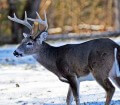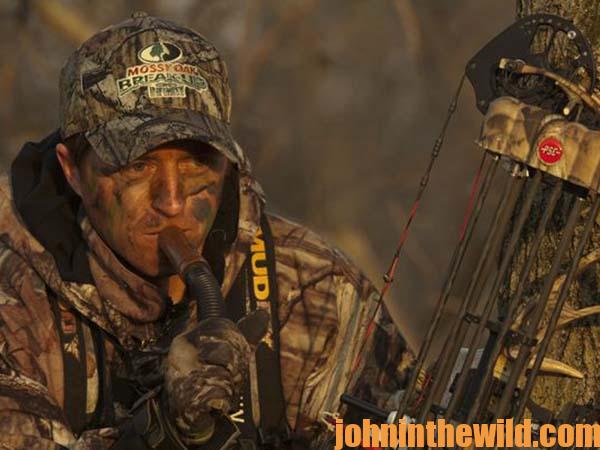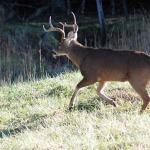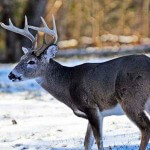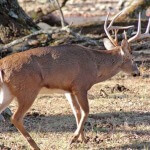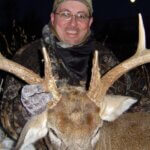John’s Note: Ernie Calandrelli of Orchard Park, New York has been shooting PSE bows (www.psearchery.com) for 30-plus years, is a member of the Mossy Oak Pro Staff (www.mossyoak.com) and Director of Publications and Advertising for Quaker Boy Calls (www.quakerboy.com). In 2014, he’s shooting the PSE DNA because he likes the speed the bow delivers, the forgiveness of this bow and the ease with which he can draw it.
I like to see deer, and if I’m not seeing deer, I like to cause deer to come and find me by calling, instead of waiting, looking and hoping that I’ll get a deer to come in to my stand site.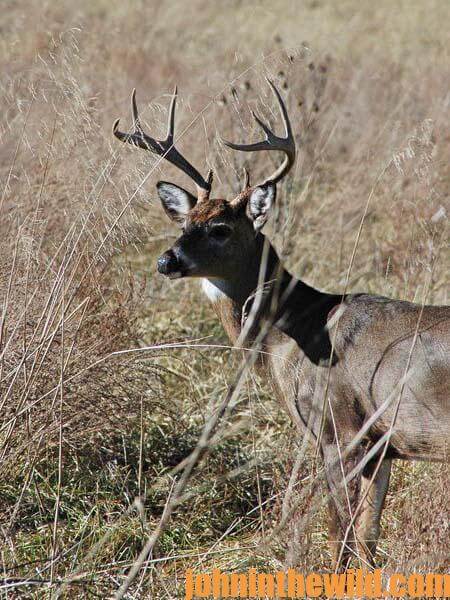
I believe I can make deer come to my stand by calling to them, and I won’t go hunting without several deer calls. Although I’m mainly a grunt call hunter, in the last couple of years I’ve changed to using the snort/wheeze call. More than likely I’ll be using the grunting and snort/wheeze together in my calling sequence. Several years ago if I couldn’t get a buck to come in by grunting to him, I’d go to the snort/wheeze. But now I’ll often start my calling with the snort/wheeze call, especially if I’m hunting in the Midwest. I’ve discovered that deer in the Midwest appear to be more aggressive than those in the Northeast. If you start off snort-wheezing, you’re attempting to sound like one buck that sees another buck and is really mad about the other buck being in his section of land. I think when you blow the snort-wheeze, you’ll bring in the more-dominant bucks. Usually an older, mean buck often will come charging in as soon as he hears a snort-wheeze call. A younger buck also may come sneaking in, but if there’s a bigger buck in the area, he’ll come in as soon as you blow the snort-wheeze call. One of the secrets to calling effectively is to make sure that you have enough light to see before you start calling the deer. I’ve heard of some hunters sitting in the dark and using the deer call just before daylight, however, I wonder what they’ll do if a big buck shows up, and they can’t take the shot. I believe the first element to calling deer successfully is to make sure you can see the deer if they come within bow range.
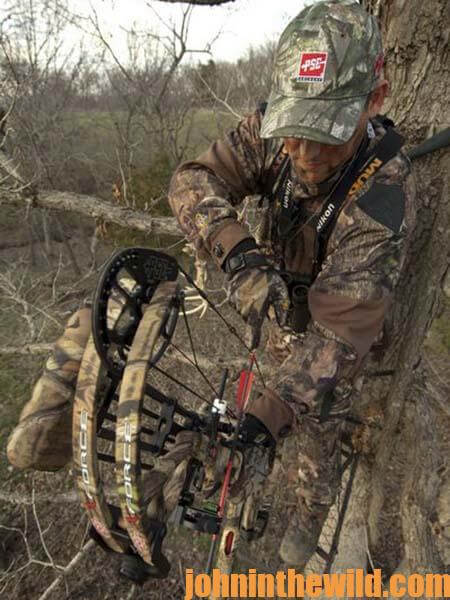 I start off calling deer like I call turkeys. I’ll begin my calling sequence with 4 – 6 low grunt calls and listen for deer moving. If I don’t hear or see any deer moving I’ll usually give two or three short snort-wheeze calls. On those mornings when there’s no wind, and you can hear forever, I’ll blow the snort-wheeze call fairly loudly. Then the deer can hear the call if he’s a long way off. I like our Deer Thugs Quaker Boy Weezzy, which we’ve partnered with Mossy Oak on to give a percentage of the sale of each call to Hope For The Warriors Outdoor Adventure Programs (http://www.hopeforthewarriors.org). Remember a deer won’t come to a call that he can’t hear. I’ve seen deer hear the call and start coming to me from 200-yards away when I’ve blown this call on a still, quiet morning or a late afternoon. The first thing that a call has to do is get the deer’s attention, so to stop the deer or to get his attention, I’ll either grunt loudly or blow the snort-wheeze call loudly. I want the deer to whip his head around or look in my direction to show that he’s heard the call, even if he doesn’t know what the call is, or what the call means. The next time he hears that call, he’ll often start moving in my direction. With that second call, the buck should be able to identify that I’m a buck, a doe grunting, or a buck giving the snort-wheeze call. I think early season is one of the best times of deer season to call in and/or take a mature buck.
I start off calling deer like I call turkeys. I’ll begin my calling sequence with 4 – 6 low grunt calls and listen for deer moving. If I don’t hear or see any deer moving I’ll usually give two or three short snort-wheeze calls. On those mornings when there’s no wind, and you can hear forever, I’ll blow the snort-wheeze call fairly loudly. Then the deer can hear the call if he’s a long way off. I like our Deer Thugs Quaker Boy Weezzy, which we’ve partnered with Mossy Oak on to give a percentage of the sale of each call to Hope For The Warriors Outdoor Adventure Programs (http://www.hopeforthewarriors.org). Remember a deer won’t come to a call that he can’t hear. I’ve seen deer hear the call and start coming to me from 200-yards away when I’ve blown this call on a still, quiet morning or a late afternoon. The first thing that a call has to do is get the deer’s attention, so to stop the deer or to get his attention, I’ll either grunt loudly or blow the snort-wheeze call loudly. I want the deer to whip his head around or look in my direction to show that he’s heard the call, even if he doesn’t know what the call is, or what the call means. The next time he hears that call, he’ll often start moving in my direction. With that second call, the buck should be able to identify that I’m a buck, a doe grunting, or a buck giving the snort-wheeze call. I think early season is one of the best times of deer season to call in and/or take a mature buck.
During the early season, especially in northern states, the bucks have to eat as much as they possibly can eat to pack  on fat for the cold hard winter coming soon. Therefore, putting your tree stand or ground blind near a food source is one of the best places I know of to take a deer. Although most hunters prefer to set their ground blinds or tree stands along a trail that deer take to a food source, I prefer to set my stand up within bow range of the food source. For instance in New York, I like to put my tree stand within bow range of an apple tree, because I know the deer will come and feed under that apple tree and mill around that tree until they’ve eaten all the apples they want. If the deer’s attention will stay on the apples on the ground rather than looking for me in the tree, I’ve got a much better chance of taking it. In New York, wild apple trees that are dropping apples in the fall are as good a deer attraction as bait is. Too, another misconception that some hunters have is you should wait for several days to hunt over a food source (like an apple tree) before you return to that tree for a second hunt. However, I have no hesitation about hunting under the same tree where I’ve previously taken a deer. In New York, we only can take one buck per season, but before I’ve also taken two does without even leaving the stand in the same tree on the same day.
on fat for the cold hard winter coming soon. Therefore, putting your tree stand or ground blind near a food source is one of the best places I know of to take a deer. Although most hunters prefer to set their ground blinds or tree stands along a trail that deer take to a food source, I prefer to set my stand up within bow range of the food source. For instance in New York, I like to put my tree stand within bow range of an apple tree, because I know the deer will come and feed under that apple tree and mill around that tree until they’ve eaten all the apples they want. If the deer’s attention will stay on the apples on the ground rather than looking for me in the tree, I’ve got a much better chance of taking it. In New York, wild apple trees that are dropping apples in the fall are as good a deer attraction as bait is. Too, another misconception that some hunters have is you should wait for several days to hunt over a food source (like an apple tree) before you return to that tree for a second hunt. However, I have no hesitation about hunting under the same tree where I’ve previously taken a deer. In New York, we only can take one buck per season, but before I’ve also taken two does without even leaving the stand in the same tree on the same day.
For more deer-hunting tips, get John E. Phillips’ Kindle eBooks “How to Hunt Deer Like a Pro,” “How to Hunt Deer Up Close: With Bows, Rifles, Muzzleloaders and Crossbows,” and “PhD Whitetails: How to Hunt and Take the Smartest Deer on Any Property,” or to prepare venison, get “Deer & Fixings.” “Click here to get these books.”
About the Author
John Phillips, winner of the 2012 Homer Circle Fishing Award for outstanding fishing writer by the American Sportfishing Association (ASA) and the Professional Outdoor Media Association (POMA), the 2008 Crossbow Communicator of the year and the 2007 Legendary Communicator chosen for induction into the National Fresh Water Hall of Fame, is a freelance writer (over 6,000 magazine articles for about 100 magazines and several thousand newspaper columns published), magazine editor, photographer for print media as well as industry catalogues (over 25,000 photos published), lecturer, outdoor consultant, marketing consultant, book author and daily internet content provider with an overview of the outdoors. Click here for more information and a list of all the books available from John E. Phillips.

